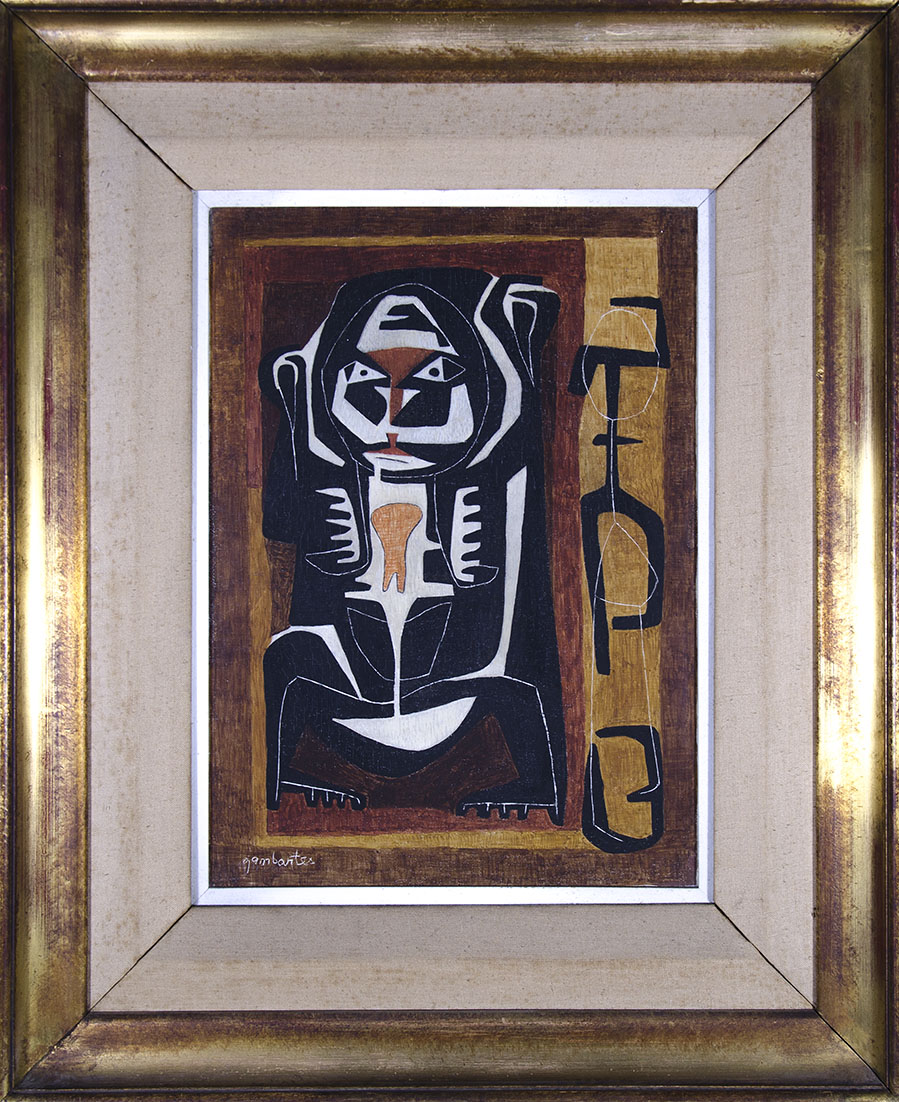BACK TO TOP
ART
AMERICANIST ART
Paye in black. Circa 1955.
Signed chrome plaster. Measurements: 41 x 30 cm. Framed artwork.
An anthropomorphic figure dominates the composition. The simplicity of the lines does not diminish the expression of the character. His gaze is deep, and his body elaborates positions typical of the payé dancing. Squatting with his feet turned in, his arms seem to be both up high in a clawed position, and at chest level with him. To his right, some black figures allude to an archaic spelling, as well as another representation of a dancing figure.
Gambartes said in an interview on Radio Nacional in 1958 (1), "The payé is a figure that has a deep telluric root (...) due to an innate and non-transferable capacity, he manages to cure ills —either by the paths of a primary medicine or through magical-religious rituals—, to predict futures and to communicate with spirits (the payé-jaguar of the Guarani) or to act as a protective god (a payé teaches the Tupíes to plant cassava)” . Two years later, in 1960, he reasoned: “I speak in the language of painting, which is universal, but I speak as a man from America, as an Argentine, of his memories and his myths, of man, of his geography, of his vegetable and mineral, with the responsibility that the still indecipherable signs of the old native cultures and the undeniable presence of contemporary sensibility mean for my spirit.” (2)
“What the artist pursues -says Elsa Flores Ballesteros- is 'that dark memory of the land that these figures represent precisely and that is symbolized in the payé (...)'. That goal guides him in the 1950s and until his death, and makes him delve deeper and deeper into a magical-mythical world whose original nucleus, in America, is indigenous. This is attested to by his multiple mythoforms, his magical characters, his peasants, his respectful quotes from pre-Columbian iconography. That is why we include his production in the indigenist orbit (in a broad sense), and that is why we say that his journey to the depths of painting is also a journey to the depths of America”. (3)
As we can see, his "Americanism" unfolds in the theme, but it is also notorious in his composition, the anthropomorphic geometry and in his mythoforms -an expensive concept in his production-, in the earthy color palette, and in the invention of a technique that characterizes it: chrome plaster, a procedure that he began to use in 1949 and that takes us back to the polychromy of ceramics and ancient American temples.
Leónidas Benigno Gambartes (Rosario, 1909 - 1963) was part of the central groups of art in his hometown: in the thirties both the Association of Plastic Artists Refuge and the Popular Mutuality of Students and Plastic Artists, the latter the core from the left promoted by Antonio Berni under the influence of David Alfaro Siqueiros; in the forties he joined the Independent Plastics Group, and in the fifties the Litoral Group (Juan Grela, Carlos Uriarte, Oscar Herrero Miranda, among others) that from a stylistic diversity represented the landscape and the inhabitants of the Santa Fe coast. Between 1937 and 1942 he composed the Cartones de Humorismo series. From 1941 he exhibited in Buenos Aires. In 1956 he participated in the XXVIII International Art Biennial in Venice, in 1957 he exhibited at the San Pablo Art Biennial, in 1958 he was invited to the Inter-American Painting and Engraving Biennial in Mexico, the Porto Alegre Pan-American Hall and the Brussels International Exhibition, where he obtained the Silver Medal.
Notes:
1. Leónidas Gambartes, interview conducted by Rubén Sevlever in 1958 and published for the first time in the catalog of the Gambartes retrospective exhibition held at the Rosa Galisteo de Rodríguez Provincial Museum of Fine Arts, Santa Fe, 1958, republished in the catalog of the retrospective of the MNBA of 1992, Fundación Gordon (AA.VV., Gambartes 1992, Buenos Aires, Ediciones PROARTIS, 1992), pp. 23‑27.
2. Interview conducted as a result of his exhibition at the Rosa Galisteo de Rodríguez Museum, in Santa Fe, in 1958.
3. Elsa Flores Ballesteros, “Introduction to the work of Leónidas Gambartes” in Gambartes, Ediciones Castagnino/macro, 2013, page 120.S.O.XVIII-OHMM
| AUTHOR | LEÓNIDAS GAMBARTES |
|---|
Are you interested in selling some works?
Send us an email briefly indicating
which works you intend to put on sale, and we will respond. click here
Subscribe to our newsletter to be updated.
Check our Newsletters